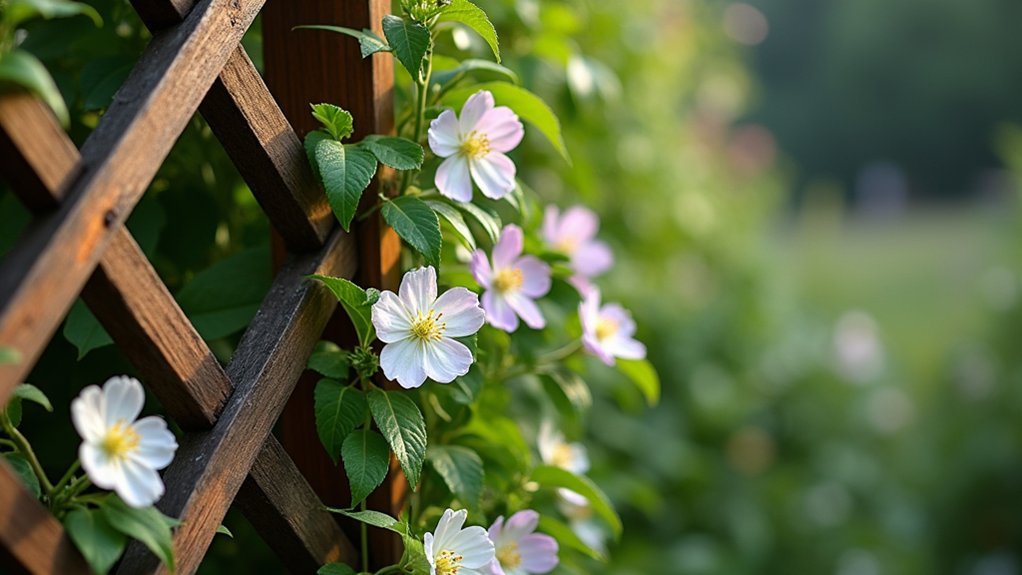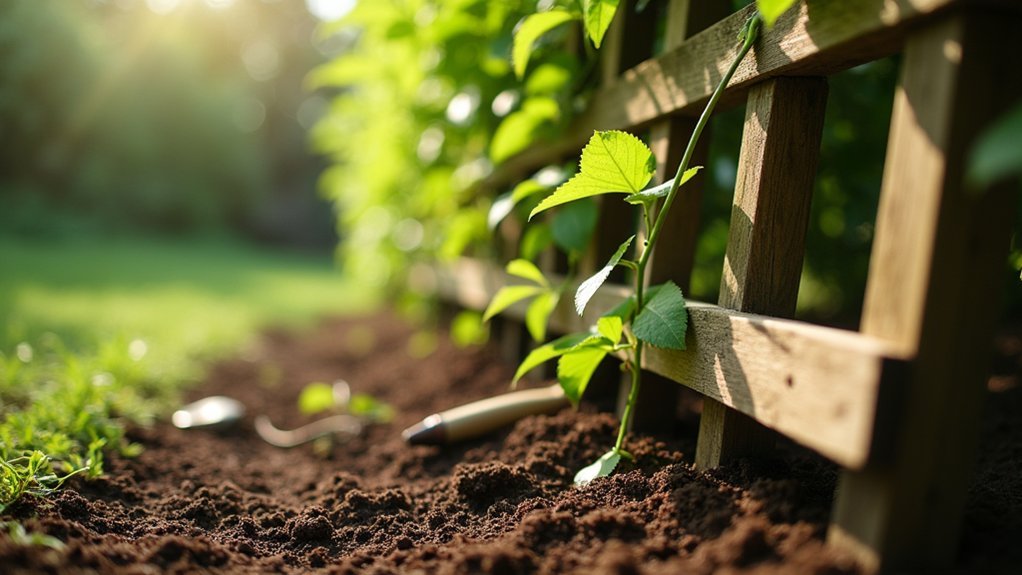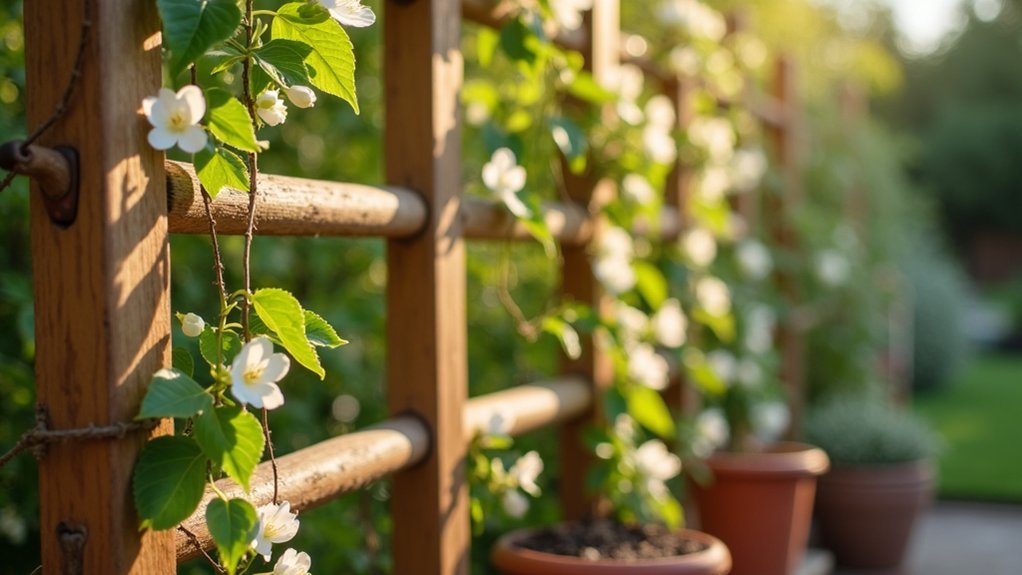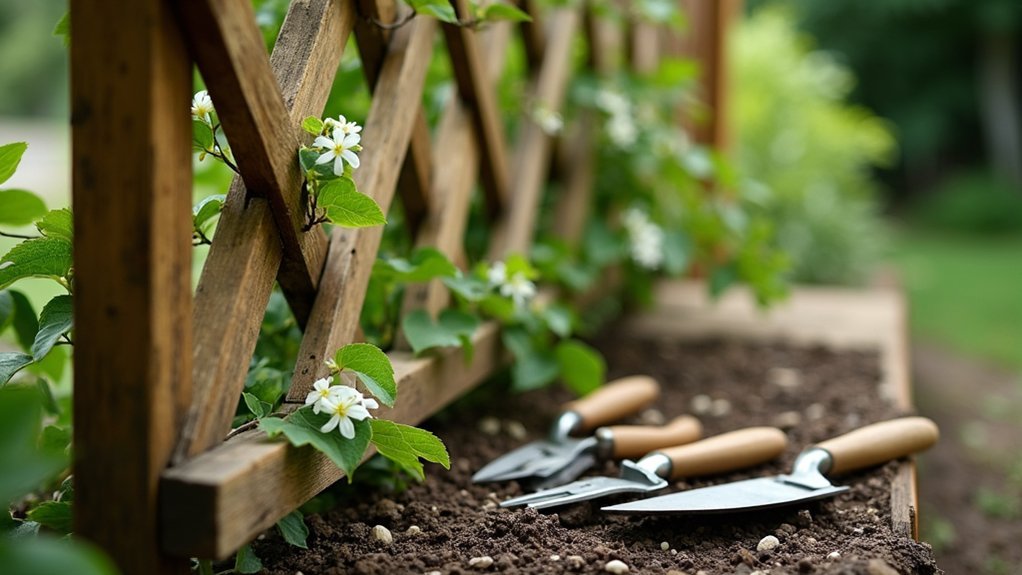To install supports for climbing jasmine, choose a structure that matches your variety’s growth habit—trellises, wires, or fencing work well. Position supports in sunny spots and secure them firmly with appropriate fasteners for your surface type. Space horizontal wires about 12 inches apart, guaranteeing they can bear the plant’s weight. Train young stems by gently tying them to the support with soft garden ties. Regular maintenance prevents sagging and guarantees your jasmine flourishes as it climbs to new heights.
Understanding Different Jasmine Varieties for Climbing

Before installing supports for your climbing jasmine, you’ll need to understand which variety you’re working with, as each has distinct growth patterns and requirements.
Jasminum polyanthum (White Jasmine) is extremely vigorous, climbing up to 30 feet and requiring robust support structures. For more versatile conditions, consider Jasminum multiflorum (Star Jasmine) with its glossy leaves and adaptable nature.
If you’re planning for moderate heights, Jasminum officinale (Common Jasmine) reaches 10-15 feet and produces sweet-scented flowers perfect for garden focal points.
For smaller spaces, Jasminum sambac (Arabian Jasmine) offers highly fragrant blooms while requiring less extensive support systems.
When selecting your climbing plant, factor in your local climate, available sunlight, and aesthetic goals, as these considerations will directly influence which jasmine varieties will thrive in your space.
Selecting the Right Support Materials for Your Jasmine
Three critical factors determine the success of your climbing jasmine: durability, accessibility, and proper orientation of support materials. When installing supports, choose PVC-coated wires over standard options for their corrosion resistance and longevity.
- Install trellises at approximately 180 cm high, or consider hiring a local handyman for custom designs that fit your specific space requirements.
- Arrange wires horizontally with vertical spacing of about one foot to prevent sagging as you train jasmine along the structure.
- Consider plastic-coated metal fencing secured with washers and screws for maximum stability and multiple fixing points.
Always guarantee your support structure allows easy access for training and tying vines as they develop. This accessibility helps maintain organized growth patterns and promotes healthier jasmine development throughout the growing season.
Planning Your Jasmine Support Structure

Successful jasmine cultivation begins with thoughtful structural planning before you install a single wire or trellis. Aim for a standard height of approximately 180cm for your support structure, allowing ample climbing space while keeping maintenance manageable.
When spacing plants, position them roughly 12 inches apart to prevent overcrowding while ensuring lush coverage. Pre-mark the locations for screws or anchors at 24-inch intervals to create a stable foundation for your climbing jasmine.
Design your support with both horizontal and vertical wires spaced about one foot apart to prevent sagging under the plant’s weight.
If you’re using a boundary fence, consult with neighbors before installation to address aesthetic concerns and structural considerations.
Choose between trellises, wire systems, or twine supports based on your garden’s specific needs and jasmine variety.
Essential Tools for Installing Climbing Supports
Proper equipment makes the difference between a sturdy jasmine support system and a frustrating installation experience.
Before you begin installing supports for your climbing plants, gather these essential tools to guarantee a smooth process.
- Impact driver – This tool reduces effort when fastening screws into supports, making the installation efficient and secure for your climbing jasmine.
- Masonry drill bit – Essential for pre-drilling holes in stucco, brick, or other hard surfaces, allowing screws to anchor securely without damaging the wall.
- Green garden wire – Creates the flexible trellis pattern that guides your jasmine as it grows, providing vital support for the climbing plants.
For different siding types, you’ll need appropriate screws or anchors to match your exterior surface and guarantee long-lasting support.
Step-by-Step Trellis Installation Process

While planning is essential, the actual installation of your jasmine trellis requires careful execution to provide lasting support for your climbing vines.
Begin by mapping out your trellis pattern with tape, marking screw locations 24 inches apart for ideal support.
Using the masonry bit included with your stucco screws, pre-drill holes to prevent wall damage. Install the screws, leaving enough head exposed to accommodate the garden wire.
Then, create a diamond-shaped grid by wrapping the green wire around each screw.
As your climbing jasmine grows, gently guide the vines onto the trellis structure, securing them with additional ties when necessary. This provides proper growth direction and prevents overcrowding.
Regular monitoring allows you to adjust supports as the plant matures and fills out your beautifully designed trellis.
Wire Systems for Jasmine Growth Support
When installing wire systems for jasmine, you’ll want to select PVC-coated wire or durable twine that resists weathering and provides lasting support for your climbing vines.
Proper tensioning techniques matter greatly—secure your wires horizontally at 12-inch vertical intervals using multiple anchor points to prevent sagging under the plant’s weight.
You can guarantee ideal growth by creating a taut wire structure that allows young jasmine shoots to climb efficiently while giving you access points for training the plant as it develops.
Wire Type Selection
Selecting the right wire for your jasmine support system can make the difference between a thriving vertical garden and a maintenance headache. When choosing wire for your climbing jasmine, prioritize materials that withstand the elements and complement your plant’s growth patterns.
PVC-coated wires offer superior longevity for outdoor installations, resisting rust and corrosion that could otherwise compromise your support structure. Green garden wire blends seamlessly with jasmine foliage, creating a natural appearance as the vines mature.
- Choose PVC-coated wires for outdoor durability and weather resistance
- Install horizontal wires with 12-inch spacing to prevent sagging as vines develop
- Consider using green-colored wire that disappears visually among the growing foliage
You’ll need to monitor your wire type selection as the climbing jasmine matures, adjusting ties to prevent overcrowding along the supports.
Tensioning Techniques Matter
Proper tension in your wire support system serves as the foundation for successful jasmine climbing. When installing horizontal wires, maintain approximately one foot of spacing between each wire to accommodate your jasmine’s rapid growth while ensuring adequate airflow.
Use sturdy supports like wooden posts or wall anchors with appropriate fasteners to secure your wires. PVC-coated options provide superior durability against weather elements, extending the life of your support structure.
Remember that tensioning techniques directly impact your climbing jasmine’s ability to ascend efficiently. Inadequate tension leads to sagging wires that hinder growth and development.
As your jasmine matures and adds weight to the system, regularly check and adjust tension accordingly. Loose wires won’t provide the stability your plant needs to climb effectively, so maintain vigilance and make adjustments as part of your routine garden maintenance.
Training Your Jasmine to Climb Effectively

Successful jasmine training requires five key techniques to transform your plant into a beautiful climber. Secure the base with soft ties that won’t damage stems but provide enough stability for the plant to grow upward. Your support structure should be at least 1.7m high to accommodate your jasmine’s climbing nature and full potential.
- Attach the main trunk to your trellis gently, leaving room for natural movement and growth.
- Check and adjust ties regularly as your plant develops to prevent overcrowding.
- Train new shoots into your desired shape through strategic pruning.
Don’t bind the stems too tightly as you train your jasmine. This restricts growth and can damage the plant. Instead, create a framework that guides without constraining, allowing your climber to flourish naturally.
Seasonal Maintenance of Jasmine Support Systems
Once your jasmine has established its climbing pattern, your attention must shift to maintaining the support structure throughout the changing seasons. Inspect your support system regularly for signs of wear, especially after winter when damage is most likely to occur.
As jasmine grows rapidly during warm months, you’ll need to adjust garden ties frequently to prevent constriction while keeping vines securely attached.
In early spring, prune overgrown shoots to maintain an organized appearance and reduce stress on your supports.
Don’t forget to monitor the spacing between support wires, adjusting them if they begin to sag under the weight of maturing vines.
Before winter arrives, apply fresh mulch around the base to protect both roots and lower support elements.
This seasonal maintenance routine guarantees your jasmine support system remains functional year after year.
Troubleshooting Common Support Structure Issues

When your jasmine support wires begin to sag under the plant’s weight, you’ll need to tighten them immediately or install additional anchor points to prevent complete collapse.
Inspect fasteners regularly for signs of rust, loosening, or damage to stem tissue, replacing any compromised hardware with appropriate weather-resistant alternatives.
If ties are cutting into growing stems, loosen them and consider switching to soft garden tape or stretchy plant ties that expand as your jasmine matures.
Sagging Wire Solutions
Despite your best installation efforts, wire supports for climbing jasmine may begin to sag as your plant matures and adds weight to the structure.
PVC-coated wires offer superior rust resistance and maintain tension better than standard options, reducing sagging concerns as you train jasmine along your trellis.
To prevent sagging wire issues:
- Space horizontal wires approximately one foot apart to distribute the weight of your climbing jasmine evenly across the entire support structure.
- Perform regular inspections of wire connections, tightening any that have loosened to uphold proper tension throughout the growing season.
- Consider installing plastic-coated metal fencing as an alternative support system that provides multiple fixing points and better weight distribution.
If sagging persists, adjust the wire orientation and height to guarantee proper vertical support while preventing overcrowding.
Faulty Fastener Fixes
Even well-installed jasmine supports can develop fastener problems as your vine grows heavier throughout the season.
When screws loosen their grip, install appropriate wall anchors specific to your siding material to provide essential additional support.
Replace any fasteners showing rust or corrosion with stainless steel or galvanized alternatives to guarantee long-term outdoor durability.
For sagging or loose garden wire, simply adjust tension at the fastening points to maintain your trellis pattern.
Perform regular inspections of all screws, as plant growth and weather can gradually loosen them.
When using PVC-coated wires as alternative supports, verify they’re properly anchored and spaced to prevent bending under your jasmine’s increasing weight.
Need additional guidance with your specific fastener challenges? Contact us for personalized faulty fastener fixes tailored to your climbing jasmine installation.
Frequently Asked Questions
How Do You Support Climbing Jasmine?
You’ll need to install horizontal wires spaced about a foot apart, use trellises or coated metal fencing, secure the plant with soft ties, and regularly adjust them as your jasmine grows.
Does a Jasmine Plant Need Support?
Yes, you’ll find that jasmine plants definitely need support. They’re natural climbers that thrive when given something to climb on, which enhances their growth, improves flowering, and creates a more attractive display.
How to Stake a Jasmine Plant?
To stake your jasmine plant, position a sturdy cane near its base, secure stems with soft ties or garden twine, and regularly adjust the ties as it grows. Install stakes when planting to avoid root disturbance later.
How to Tie Jasmine to a Trellis?
To tie jasmine to a trellis, use soft garden twine or flexible ties. Secure the main stems in a figure-eight pattern, leaving room for growth. Don’t tie too tightly—you’ll damage the plant.
In Summary
You’ve now learned the essentials of installing supports for your climbing jasmine. By choosing appropriate materials, planning properly, and installing your trellises or wire systems carefully, you’ll create a beautiful vertical display. Remember to train your vines regularly and perform seasonal maintenance. With these steps, you’ll enjoy your jasmine’s vibrant blooms and fragrance for years to come.





Leave a Reply